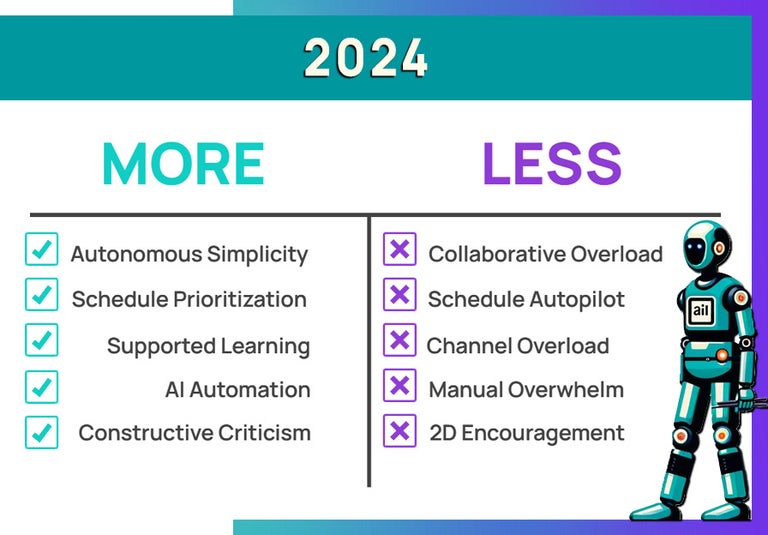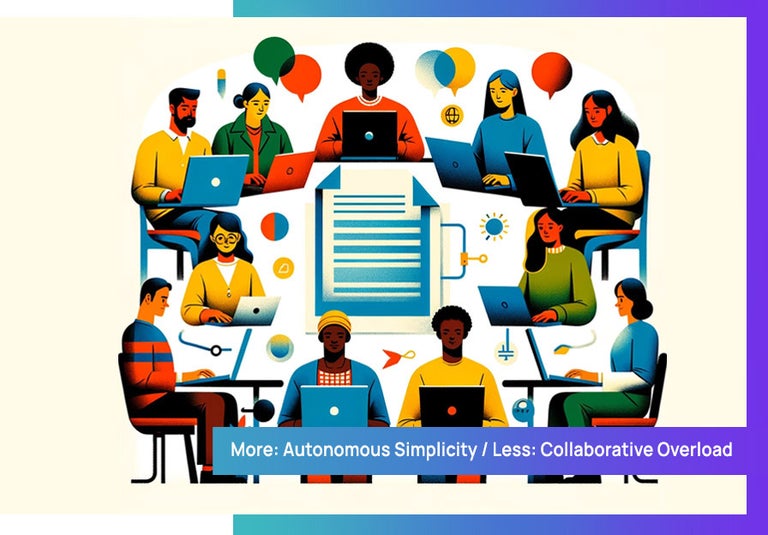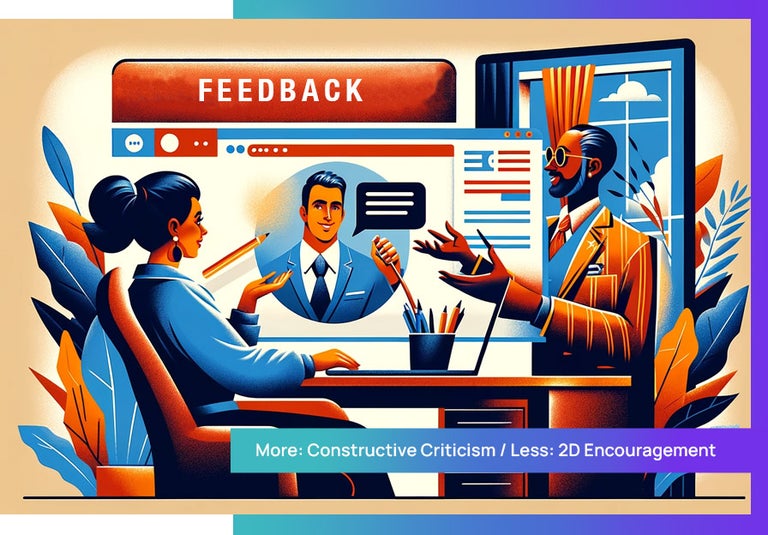Contents
- A Discovery of Not-So-Smart Goals
- Emmanuel’s Theory That Goal-Setting is BS
- What IS a More/Less List?
- Why More/Less Lists Have Value
- Your Remote Team Leadership More / Less List for 2025
- Creating Your Achievable 2025 Goals
The end of ‘goal setting as usual’ has arrived, and we have Gen Z to thank. Instead of the usual SMART goal lists I’ve been seeing online for the past decade, something altogether new has emerged. And it caught me off guard.
Because it’s better in a lot of ways.
Last week I sat down to draft a fresh batch of goals and was filled with – apprehension?
There are a few goals I didn’t quite check off the list last year. These particular goals were happy to migrate to my new list, where they would nest and fester. Not on the journal page, but in my mind for the next several weeks: until I resolved to do better.
Eventually to escape the ghosts of my unfulfilled goals, I turned to TikTok.
A Discovery of Not-So-Smart Goals
Before I knew it, I came across a TikTok goal setting method that strips away the stress of the system I’d been using for years. One that I learned (not for the first time) at Uni during my undergrad years, and then re-learned while doing my MBA years later.
SMART goals. You know them – all remote managers do. These goals have to be specific, measurable, attainable, realistic and timely or forget it: you fail.
But that’s not the truth, is it?
For goals to be effective they don’t have to be any of those things.
Surprise!
Just ask the greatest guitarist who ever lived: Jimi Hendrix. He didn’t set a goal to become the best guitarist in the world, he just played every day. Because of the freedom he had with his instrument, he learned it more intimately than anyone else.
If he’d set a goal and gone to lessons – we may never have heard music from an upside-down guitar played by a left-handed genius. The point is: rigidity is not always the best policy.
Gen Z is showing us the light – and I was shook.
· Why did goal-setting come with emotional damage?
· What made SMART goals the Emperor of all methods?
· Were SMART goals still even smart?
Leading globally distributed teams is complex and tricky. I suspected that the fixed nature of SMART goals was doing more harm than good. So, I set out on a quest to find others who felt the same.
And I found an interesting TedTalk by Emmanuel Acho.
Emmanuel’s Theory That Goal-Setting is BS
In his talk, Emmanuel raises some concerns about modern-day goal setting.

He says that:
- It forces you to hyperfocus on one thing (to the exclusion of all other possibilities)
- It drives you to sacrifice for that goal (and not always in healthy ways)
- It limits what you can achieve by becoming a fixed idea (inflexible and rigid)
Now, imagine setting a SMART goal for your remote team, but because of the pace of tech – what you’ve done is forced a fixed, limited goal on everyone that makes them self-sacrifice for that one thing only.
Making them blind and deaf to everything else.
One example is AI upskilling in remote work right now. If it’s not a SMART goal – guess what? It’s not being done. No-one has a moment of extra energy when ambitious SMART goals are set.
These goals take your team and turn them into racehorses, blinkers and all.
RIP Innovation. Sayonara creative possibilities. Hello mediocre or failed performance.
But look at this:
- Only 14% of employees say SMART goals will help them achieve great things
- They were created for a different era (The era of authoritarian management)
- SMART goals are generally not great or audacious enough!
- They’re ‘emotionally unattractive’ because they often lack ‘why?’
So: SMART goals are out, and More/Less Lists are in.
Okay, let’s get into Gen Z’s version of goal-setting: More / Less Lists.
What IS a More/Less List?
For Gen Z the More / Less List is the perfect New Year’s goal-setting tool. It’s nearly the exact opposite of SMART goals, but the funny thing is that it performs where SMART goals fall flat.
They started out as visual lists and have gradually become word lists too, popularized in short TikTok videos.
There is a HUGE TikTok community of people making their More/Less Lists right now. It’s crossed into the business world in a big way – and I’m excited about that.

The premise is easy enough:
- Keep the list ultra simple
- List MORE of what you want in your life/job/team/process
- List LESS of what you don’t
Also called the ‘in/out list’ these simple lists are a linguistic vision board of goals, and a great way to set your intentions for 2025. Best of all, they come without any of the downsides of SMART goals.
- They’re broad and non-specific
- They’re stress-free because they’re hard to fail
- They leave room to be as small or as big as you have capacity for
- They’re inspiring guides instead of a racetrack
These new goals can be a more effective guiding force for your remote team in 2025.
If like me, you’ve found traditional-goal setting falls short – here’s your why.
Why More/Less Lists Have Value
· More / Less Lists aren’t SMART
What defines your more/less list this year won’t be specific, measurable, relevant or time bound. The only factor that matters is achievability.
This flies in the face of goal setting 101, but doesn’t change the data. Writing down your goals (even if they aren’t SMART goals) still results in a 42% higher likelihood of achieving them.
· Achievable goals are in
For remote managers, there are enough OKRs, KPIs and metrics to manage without adding to an already feverish workload.
Gen Z’s don’t give a fig about adding more metrics to their numerical salad of to-dos. Instead of 83% of you not setting any goals, lets focus on expanding the existing 8% who set and achieve them. The priority of your more/less list is to be as achievable as possible.
· Sharing your goals with your team is in
Your goals can be flexible, iterative or an act of ongoing mindfulness. The key here is that you share them with your team, so that everyone acknowledges what is important, and what isn’t.
Studies have shown that 70% of people who share goals, achieve them. Put yours on your virtual whiteboard, or in a shared digital location.
As a remote leader - stepping into the New Year is going to have its own unique blend of challenges. And, depending on your team’s maturity – you’ll want to set goals for the year that everyone will love, support and strive for.
Use our more/less list to help you build one of your own – and gently level-up how your team performs across time-zones in 2025.
Your Remote Team Leadership More / Less List for 2025
Working remotely covers a series of skills that can be upgraded, developed or expanded upon every year. For remote managers, these are the goals to focus on to level-up your game in the coming months.
When I sat down to think about the most important intentions to set in 2025, some themes emerged: simplicity, prioritization, focused learning, automation and criticism.
Unlocking these 5 areas will help you become a more accomplished remote leader and will inspire your team to excel.

1. Streamline and Simplify the Way You Work Remotely

More: Autonomous simplicity
Less: Collaborative overload
Ever heard the phrase ‘too many cooks in the kitchen?’ With a distributed team working asynchronously, it can be challenging to keep things simple.
Everything from BHAG goals, to project scope, to single decisions can become overly complicated – because everyone wants to contribute.
I wrote recently about the dangers of collaborative overload in remote teams, and how a closed-door policy can be beneficial for everyone.
Harvard Business Review has published extensively on the 50%+ boom in collaboration at work, which is the enemy of productivity.
Competing needs and demands, not picking your battles, and an emphasis on teamwork has resulted in unnecessarily complex inputs and outcomes in remote environments. In 2025, we want more fact-based simplicity driven by autonomous individuals, and less collaborative overload.
Lead this year by streamlining and simplifying your team’s HOW. They will be grateful for it.
2. Become a Pro at Prioritizing What Matters (and What Doesn’t)

More: Schedule prioritization
Less: Schedule autopilot
Most people prioritize their schedule when they should schedule their priorities.
As a remote leader, it’s the difference between falling behind constantly, or being able to manage any workload – no matter the twists and turns. When you’re up against time-zone differences, anything can happen.
Do you make space for yourself and your team to absorb and respond to rapid change?
Take back control in 2025 by leveling up the way you prioritize tasks in your day. That means using tools like The Eisenhower Matrix to prioritize daily tasks on your schedule, every day as they change.
This year we want more intentional schedule prioritization, and less schedule autopilot.
Lead your remote team to scheduling success by becoming a daily prioritization pro.
3. Provide Support, Structure and Limitations on Communication Processes

More: Supported learning
Less: Channel overload
Channel overload (also called information overload) is a remote communication killer. The sheer volume of inane, unimportant or ‘additional’ info the average remote manager has to process is enough to dial up anyone’s cortisol response.
There’s too much unorganized data, messages and channels that we’re all on. No wonder active learning has become so incredibly difficult.
With 80% of digital workers impacted by information overload, it’s a big deal. Too much information impacts all sorts of critical areas – like learning and focus.
Unsupported learning can result in critical gaps in knowledge, inaccuracies and blind spots. Shallow work from constant communication flow means less time for focused deep work, innovation and creativity.
In 2025 we want more supported learning via paid courses (internal or third-party) and deep work, and less channel overload by creating structured documentation, logical management hierarchies and better rules regarding who can and can’t be contacted.
Lead your team into a more knowledgeable and focused 2025 by leveling up remote communication.
4. Adopt Every AI Automation Tool That Accelerates Productivity

More: AI Automation
Less: Manual Overwhelm
The bane of every remote manager’s existence is manual administration and processes that take forever. It’s easy to fall into a state of constant overwhelm when you’re trying to do things manually in a fast-moving digital world.
The key of course, is automating wherever you can.
AI has come to our rescue and managers can now automate tasks at lightning speed. AI-powered remote work includes adopting tools like Notion, ChatGPT, Descript, Grammarly, Reclaim, genei, and Mem to name a few.
These are game-changing productivity accelerators that will be huge in 2025.
And this is the year to get serious about them – because your competitors are, and the AI gap is widening. Upskilling in this specific area will keep your remote team on the cutting edge of tech.
This year we want more AI automation and less manual overwhelm overall. Lead your remote team to higher levels of measurable productivity when you set this intention.
5. More Constructive Criticism, Less 2D Encouragement

More: Constructive Criticism
Less: 2D Encouragement
They say beginners are motivated by encouragement, while experts are motivated by constructive criticism.
And that’s because experts need help identifying areas of improvement, while beginners are improving in general as a whole. Interesting stuff in the context of remote working.
Feedback in general is essential to high functioning teams, but knowing how and what kind of feedback works in various situations is valuable.
To be on a remote team full time means that you are more likely to be an expert, and require a deeper level of constructive criticism where it counts.
As a remote leader, refining your ability to give constructive criticism will gradually improve your team’s performance. That means working on the fear that keeps you from tactfully expressing areas of improvement for your team. As Gallup says, fast feedback fuels performance.
This 2025, we want more constructive criticism at the right moments for your team, and less 2D encouragement or praise when – in reality – constructive criticism would have been better.
Creating Your Achievable 2025 Goals
These are the goals for our remote team that we’ll carry into this year.
I’m not saying delete SMART goals from your management toolkit, but treat them with caution. They’re effective in some areas, and not in others!
I’m going to do it while leaving space for surrounding possibilities, disruptions, and other important priorities to spring up and take over where needed.
If there’s one thing we know for sure in tech, it’s that change is coming.
The dawn of 2025 presents an extraordinary opportunity to reshape and refine your leadership and team dynamics. The more/less list offers a flexible framework for setting goals that adapt to the unpredictable nature of remote work in the tech space.

The essence of effective remote leadership lies in simplicity, prioritization, and adaptability.
- Embrace autonomous simplicity to avoid the pitfalls of collaborative overload
- Encourage schedule prioritization over autopilot routines
- Foster an environment of supported learning, steering clear of channel overload
- Leverage AI automation to minimize manual tasks
- Prioritize constructive criticism over superficial encouragement
Next year, challenge yourself to lead with intention and mindfulness. Share your goals with your team, fostering a culture of accountability and collective growth.
If you do, you’ll likely be among the 70% who achieve their shared goals.
Let your more/less list be a guiding beacon, not just a set of rigid objectives, but a dynamic, evolving vision that helps you navigate through the complexities of remote work.
You want it to be more like a guided nature walk than horses in a horse race. Ultimately, you’ll see more on the journey!
As Emmanuel Acho says, let go of the captivity of goal setting and achieve all you actually have to achieve. Do more of what will improve your remote team, and less of what’s been holding you back.
Who knows how far you’ll get this year when you don’t put a limit on what is possible. Take 10 minutes right now to draft your own more / less list for 2025.









